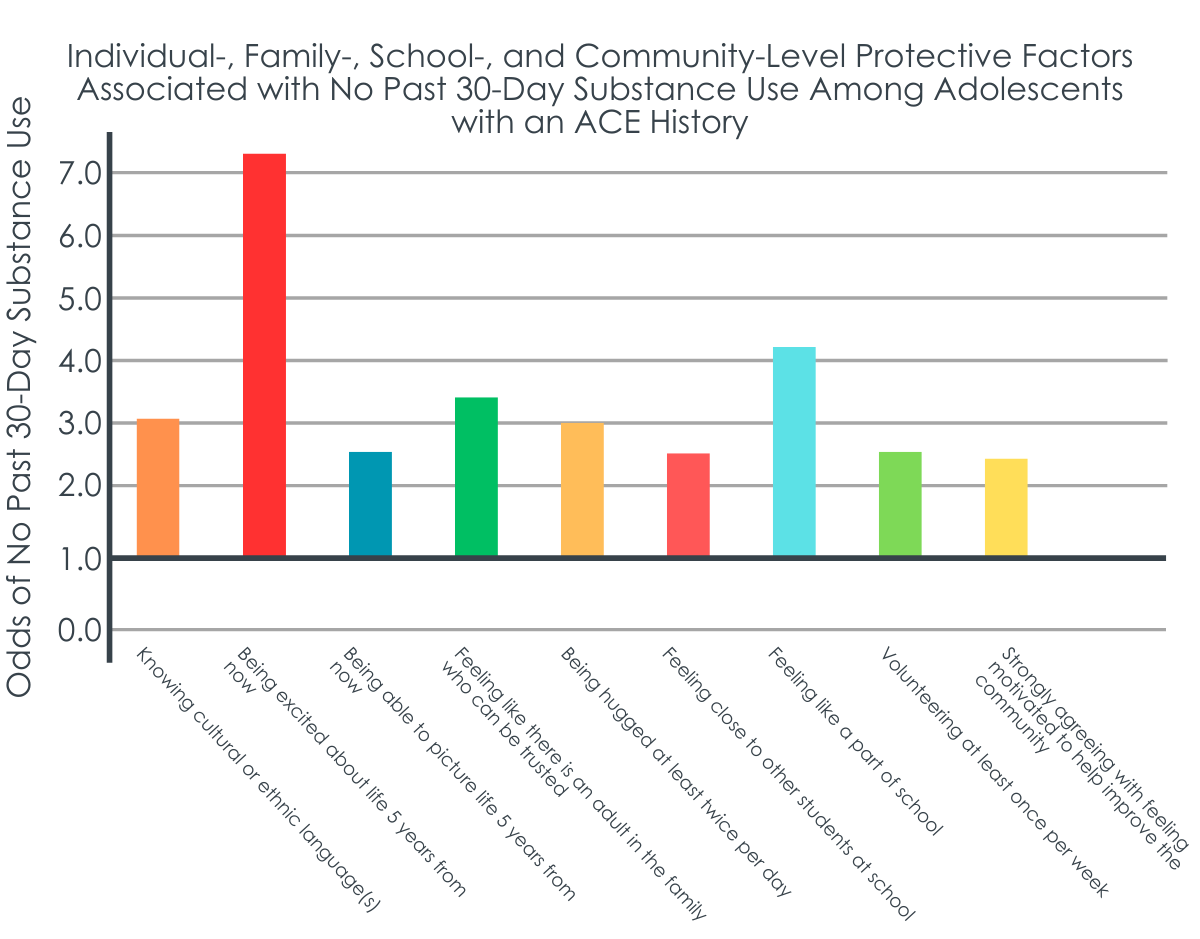Adolescents that have experienced adverse childhood experiences are more likely to use substances. Yet, adolescents are also resilient. This study sought to explore what individual, family, school, and community–level factors buffer the negative effects of adverse childhood experiences on the likelihood of substance use among adolescents.
WHAT PROBLEM DOES THIS STUDY ADDRESS?
Adolescence is a developmental period marked with unique clinical qualities making adolescents different from their younger and older counterparts. For instance, the onset and initial trends of substance use that typically occur during adolescence are significantly shaped by social and environmental elements, whereas subsequent usage levels are more heavily impacted by genetic factors. Furthermore, young people are undergoing significant neurocognitive, socioemotional, and psychological changes, which can be interrupted, altered, and delayed due to the misuse of substances. Preventing and diverting substance use during adolescence may help reduce the likelihood of a future substance use disorder, overdose, poor academic and work outcomes, and a host of other health outcomes which can have life-long ramifications.
Although experimentation with substances often begins during adolescence, youth that have experienced adverse childhood events are at an increased risk. An adolescent with even one ACE is more likely to use substances than their peers without an ACE. ACEs include harms that a child may directly (e.g., abuse and neglect) or indirectly (e.g., parental conflict) experience. A meta-analysis, or study of studies, found that if an adult has four or more ACEs they are 10.22 times more likely to engage in problematic substance use than if they had less than four.
The study of the causes or origins of substance use date back decades if not centuries. However, the emergence of addiction recovery science has shifted the discourse surrounding substance use and recovery. One feature of this dynamic shift has been a larger focus on the strengths and protective factors individuals have. For example, recovery capital has emerged has an organizing frame to represent the total resources an individual can access to support their recovery. Recovery capital often includes factors at the individual, family, community, and societal levels. Of note, recovery and recovery capital among adolescents is unique from that of adults, which necessitates a special focus on their unique experiences. Prior to problematic substance use, developing and supporting protective factors among individuals that may be at heighted risk for later substance use problems could help prevent those problems or reduce time to problem resolution. This study explores individual, family, school, and community factors that may be protective of substance use among adolescents that have reported adverse childhood experiences.
HOW WAS THIS STUDY CONDUCTED?
This cross-sectional study analyzed baseline data collected between July 2017 and October 2018 from the Well-Being and Experiences study (WE Study), which included 1002 adolescents aged 14 to 17 years old and lived in Manitoba, Canada. The WE Study recruited adolescents and their caregiver though random phone number dialing (21%) and convenience sampling (79%) from referrals and community advertisement. Only adolescent data were used in this study. Upon study participation, adolescents and their caregiver both provided informed consent and completed surveys in separate rooms. Adolescents were assured that their caregivers would not see their responses.
A history of 13 adverse childhood experiences (ACEs) were asked about, which included emotional neglect, emotional abuse, exposure to verbal intimate partner violence (IPV), spanking, peer victimization, parental separation or divorce, parental trouble with police, parental gambling, foster care or child protective organization contact, household substance use, household mental illness, household poverty, and living in an unsafe neighborhood. A binary “Any ACE” variable was also created. These 13 ACEs were chosen based on a previous study by the authors. Each ACE-related question(s) were dichotomized to represent whether the adolescent experienced that ACE or not. For example, emotional abuse was assessed with a single item that asked, “How many times in the past 12 months did a parent or other adult living in your home swear, insult, or say hurtful or mean things to you.” If a participant responded once a month or more frequently, the item was coded as having experienced emotional abuse. Other ACEs were assessed using scales. For example, peer victimization was evaluated with 7 items, with response options ranging from never to every day on a 9-point scale. One item within that scale asked how many times in the past 12 months a friend, peer, someone at school, or another young person had bullied, picked on, or said mean thing, or threatened them through texting or the internet. If a respondent reported once a month or more frequently to any of the 7 items, they were marked has having experienced peer victimization. Physical abuse, sexual abuse, and physical neglect were not included in this study due to the child welfare mandatory reporting laws, which would necessitate mandatory reporting and potentially legal intervention as a result of an adolescent reporting any of these experiences.

Adolescents reported their past 30-day cigarette, alcohol (binge drinking or intoxication), and cannabis use. However, there were too few positive reports of substance use to assess each substance individually. Thus, a binary substance use variable was created that represented any cigarette, alcohol (binge drinking or intoxication), or cannabis use in the past 30 days. Respondents also reported on 28 unique protective factors. Individual-level factors included things like physical activity, social support, and sleep. Family-level factors featured concepts such as trust with caregiver and how often a caregiver hugs or says “I love you”. School-level factors included having at least one close friend at school and feeling like a part of the school. At the community-level, factors included things like feeling involved in the community, feeling motivated to help and improve the community, and having an adult to trust in the community.
WHAT DID THIS STUDY FIND?
Adverse childhood experiences (ACEs) were associated with past 30-day substance use.
This supports a body of scholarship identifying a link between ACEs and substance use. In particular, 12 out of the 13 unique ACEs were associated with past 30-day substance independent of gender, race/ethnicity, and total household income. Spanking was the only ACE not tied to substance use. Household substance “abuse”, parental gambling, parental trouble with the police, and living in an unsafe community had the strongest associations with substance use with increased odds of substance use ranging from 3.15 to 4.21. For example, if an adolescent reported parental gambling, they were 4.21 times more likely to also report past 30-day substance compared to their peer who did not report parental gambling, after accounting for the effects of gender, age, race/ethnicity, and total household income on the odds of substance use. The odds of past 30-day substance use are 2.90 times higher if an adolescent reported any ACE compared to those that did not report any.
Individual, family, school, and community-level factors were protective of substance use.
Several individual-level factors were protective. For example, strongly agreeing with the statement “I know my cultural or ethnic language or languages” was linked with 3.01 higher odds of no past 30-day substance use. Being excited about and being able to picture life 5 years from now were tied to 7.13 and 2.58 higher odds, respectively, of not using substances in the past 30 days. At the family level, feeling like there is an adult in the family who can be trusted is tied to 3.42 higher odds of not using substances. Being hugged at least twice per day is also linked with about 3 times higher chances of not using. Feeling like both mother/mother figure and father/father figure understand problems and worries and can be confided in were associated with higher odds of not using, ranging from 1.95 times to 3.68 times. At the school-level, adolescents who felt close to other students at school were 2.53 times more likely to not report past 30-day substance use. Those that felt they were a part of their school were 4.19 times more likely to report no substance use in the past 30 days. At the community level, those that volunteered at least once a week were 2.59 times more likely to report no use compared to those that never volunteered. Adolescents that strongly agreed with feeling motivated to help and improve their community were 3.43 times more likely to not report substance use compared to those that strongly disagreed. All of these associations accounted for the combined effect of gender, age, race/ethnicity, and total household income on past 30-day substance use.

Figure 2. Odds ratios indicate the likelihood of something occurring, where an OR above 1 means that it is more likely to occur. For example, adolescents who volunteer at least one a week were more likely to have no past 30-day substance use compared to adolescents who do not volunteer.
WHAT ARE THE IMPLICATIONS OF THE STUDY FINDINGS?
This study examined 28 possible factors protective of substance use among adolescents that reported adverse childhood experiences (ACEs). Adults with ACEs are significantly more likely to report substance use, substance use disorders, poor health, and many other health conditions. This study found that adolescents with ACEs are also more likely to engage in substance use. However, this research is particularly important because identifying protective factors among adolescents with ACEs may help develop prevention and intervention programs to promote resilience and reduce substance use.

Unfortunately, many children experience adverse events that impact their health and health behaviors well into adulthood. However, many young people are incredibly resilient—they possess the ability or resources to cope with adversity or trauma—and use substances less. Identifying what types of factors (i.e., individual vs family vs school vs community) and what specific factors are tied with not using substances could help programs increase resilience among this high-risk population. Individuals, families, communities, and policy makers could leverage these findings to strengthen resilience among young people.
Findings from this study suggest that individual, family, school, and community-level factors might potentially buffer against past 30-day substance use. To the extent that at least some of these factors are fully or partially causally related to substance use, at the individual-level, programs could work to promote and strengthen identity and linguistic knowledge of a young person’s ethnic heritage. Programs could also encourage perspective taking and future-oriented thinking. By the far the largest effect found was the relationship between being excited about the future and not using. Adolescents were more than 7 times as likely to report not using substances when they were excited about their future. Across levels, the adult-adolescent bond is consistently related to substance use. Adolescents that had an adult in the family or at school they could trust were 2-3.5 times more likely to report no substance use. Furthermore, adolescents are likely to benefit from being linked to volunteer opportunities and nurturing a commitment to helping and improving their community.




